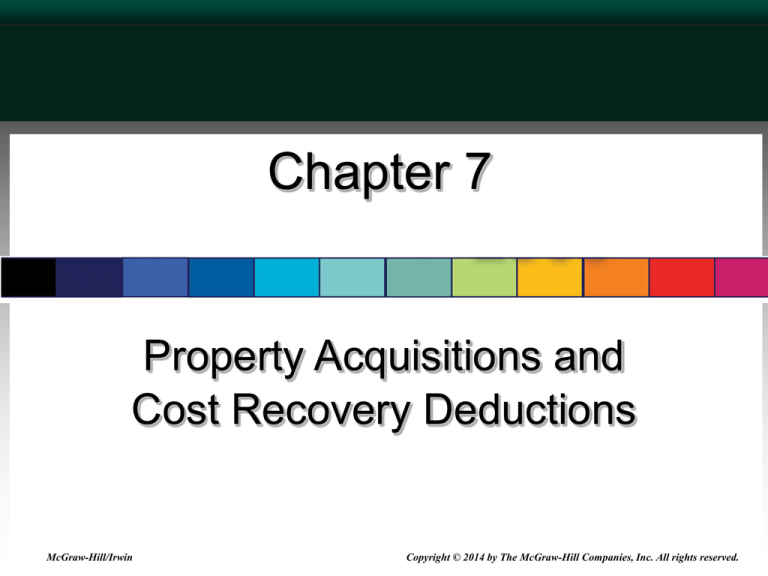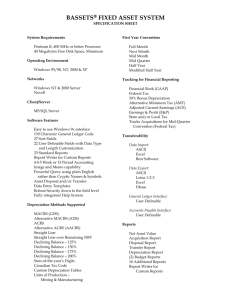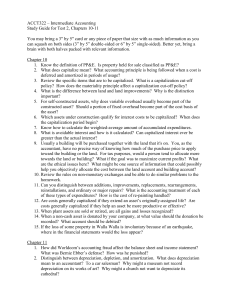
Chapter 7
Property Acquisitions and
Cost Recovery Deductions
McGraw-Hill/Irwin
McGraw-Hill/Irwin
Copyright © 2014 by The McGraw-Hill Companies, Inc. All rights reserved.
© 2007 The McGraw-Hill Companies, Inc., All Rights Reserved.
7-2
Objectives
Decide if an expenditure should be deducted or
capitalized
Define tax basis and adjusted basis
Explain why leverage can reduce the after-tax cost
of assets
Compute cost of goods sold for tax purposes
Understand the MACRS framework
Apply the Section 179 expensing election
Compute amortization of purchased intangibles
Distinguish between cost and percentage depletion
7-3
Expense or Capitalize?
Deduction allowed for all ordinary and necessary
business expenses
Deduction prohibited for permanent improvements
to increase the value of property
Cost of improvement is capitalized
7-4
Capitalized Costs
Similar to GAAP, if an expenditure creates or
enhances an identifiable asset with a useful life
substantially beyond the current year, the
expenditure must be capitalized
Some capitalized costs can be recovered through
depreciation, amortization, or depletion deductions
A capitalized cost that is not depreciable, amortizable, or
depletable is recovered only on disposition of the asset
7-5
Expense or Capitalize?
Repairs and maintenance
Expenditures that are regular and recurring in nature and
do not materially add to either the value or the useful life
of an asset are deductible
Repair and maintenance expense
The distinction between a repair and a capital
improvement is frequently a matter of dispute between
taxpayers and the IRS
7-6
Tax Subsidies Permit Expensing
The tax law permits immediate expensing of certain
capital expenditures
Indirect federal subsidy for taxpayers who make these
tax-preferred expenditures
One example is research and development (R&D)
expenditures
Indirect federal subsidy to encourage business to engage
in basic research
7-7
Tax Subsidies Permit Expensing
Other examples include:
Advertising
Industry specific deductions:
Farmers can deduct soil and water conservation
expenditures as well as the cost of fertilizers
Oil and gas producers can deduct intangible drilling and
development costs (IDC) of wells
7-8
Tax Basis
Basis is key to calculating cash flows because
taxpayers recover basis at no tax cost
Tax basis = unrecovered dollars represented by
an asset
Every asset has a tax basis
In most cases, the initial basis of an asset is cost
Cost is the FMV of cash, property, or services
expended to acquire an asset
Includes sales tax and incidental costs relating to
placing the asset in service
7-9
Adjusted Tax Basis
Adjusted basis equals initial basis reduced by
depreciation, amortization, or depletion deductions
An asset’s adjusted tax basis may be different than
the asset’s adjusted book basis
Initial book and tax basis may be different
Book and tax recovery deductions may be different
≠
7-10
Tax Basis and Leverage
Leverage is the use of borrowed funds to purchase
assets
Cost basis includes the amount of borrowed funds
Firm A used $10 of its own cash and $80 of borrowed
cash to buy an asset
Firm A’s cost basis is $90
Interest paid on borrowed funds is deductible
7-11
Cost Recovery Methods
Inventory = cost of goods sold
Tangible assets = depreciation
Intangible assets = amortization
Natural resources = depletion
7-12
Cost of Goods Sold
Calculating cost of goods sold
Beginning inventory
Capitalized costs
Inventory available for sale
(Ending inventory)
Cost of goods sold
Capitalized costs may be greater for tax than book
Unicap rules for capitalization of indirect costs (overhead)
Temporary unfavorable book/tax difference
Reverses through cost of goods sold
7-13
Inventory Valuation Methods
Taxpayers may value ending inventory and cost of
goods sold by using:
Specific identification method
First-In, first-out convention (FIFO)
Last-in, first-out convention (LIFO)
Must be consistent with financial reporting
7-14
Depreciation
Depreciation applies to tangible assets that:
Lose value over time due to wear and tear, obsolescence
Buildings are depreciable but land is not
Have a reasonably ascertainable useful life
Artwork is not depreciable
7-15
Depreciation
Before 1981, tax depreciation was based on an
asset’s estimated useful life. Under MACRS,
estimated useful life is irrelevant
The MACRS recovery period is usually shorter than
an asset’s estimated useful life. What affect does
this have on the purchasing behavior of firms?
The shorter lives reduce the after-tax cost of the assets
and acts as an incentive for firms to make capital
acquisitions
7-16
MACRS Recovery Periods and Methods
Depreciation for 3, 5, 7, and 10-year recovery
property is computed under the 200% declining
balance method
Depreciation for 15 and 20-year recovery property
is computed under the 150% declining balance
method
Depreciation for 25, 27.5, 39, and 50-year recovery
property is computed under the straight-line
method
7-17
Depreciation Conventions for Personalty
Depreciation for 3, 5, 7, 10, 15, and 20-year recovery
property (personalty) is generally based on a half-year
convention
One-half year of depreciation is allowed for the year in
which property is placed in service
Convention built in to IRS Tables
One-half year of depreciation is allowed for the year in
which property is disposed of
Not built into IRS Tables
Midquarter convention applies if more than 40% of
personalty acquired in a year is placed in service in the 4th
quarter
7-18
Depreciation Convention for Realty
Depreciation for 25, 27.5, 39, and 50-year
recovery property (realty) is based on a midmonth
convention
One-half month of depreciation is allowed for the month
in which property is placed in service
Convention built into IRS Tables
One-half month of depreciation is allowed for the month
in which property is disposed of
Not built into IRS Tables
7-19
Limited Depreciation for Passenger Automobiles
Maximum annual depreciation per vehicle placed
in service in 2012
2012
2013
2014
2015
$3,160
$5,100 (2nd year)
$3,050 (3rd year)
$1,875 (4th year and beyond)
Compute depreciation per MACRS, then apply the
limit
7-20
Section 179 Expensing Election
Taxpayer may expense a limited amount of cost of
qualifying property placed in service in a year
Limited amount is $500,000 in 2013
Qualifying property is depreciable personalty and off-theshelf software
Capitalized cost (unexpensed) is recovered through
MACRS
Limited amount is reduced by the aggregate cost
of qualifying property in excess of a threshold
Threshold is $2,000,000 in 2013
7-21
Section 179 Example
Mayer Inc. purchased $609,200 of qualifying
property in 2013
Mayer may expense $500,000 of the cost and capitalize
$109,200 as the depreciable basis of the property
Lowe Inc. purchased $2,070,000 of qualifying
property in 2013
Lowe must reduce its limited amount by $70,000
($2,070,000 - $2,000,000 threshold)
Lowe may expense $430,000 of the cost ($500,000 –
$70,000) and capitalize $1,640,000 as the depreciable
basis of the property
7-22
Taxable Income Limitation
The deduction for a Section 179 expense is limited
to taxable business income before the deduction
Any nondeductible expense carries forward to future
years
In 2013, Boyd Inc. elected to expense $112,000 of
the cost of qualifying property
Boyd’s taxable income before any Section 179 deduction
was $91,800
Boyd’s Section 179 deduction is limited to $91,800
Boyd has a $20,200 expense carryforward to 2014
7-23
Bonus Depreciation
100% bonus depreciation permits immediate
expensing of 100% of the cost of qualifying
property placed in service after September 8, 2010
and before January 1, 2012
Qualifying property is new depreciable personalty,
computer software and certain leasehold improvements
50% bonus applies to acquisitions after December
31, 2012 and before January 1, 2014
7-24
Bonus Depreciation Example
Evans Inc. acquired new depreciable personalty
costing $4 million on January 3, 2013
Evans could deduction $2 million ($4 million × 50%) in
2013 using bonus depreciation
The remaining $2 million depreciable basis would be
recovered under MACRS, beginning in 2013
If the property were acquired on January 3, 2011
Evans may deduct the entire $4 million cost in 2011 using
bonus depreciation
7-25
Intangible Assets
Intangible assets have no physical substance
Examples include leases, patents, and other contractual
rights
The basis of an intangible asset is amortized on a
straight-line method over the determinable life
Intangible assets with no determinable life are not
amortizable
Examples include securities and partnership interests
7-26
Organizational and Start-Up Costs
Organizational costs of a corporation or partnership include
legal, accounting, and filing fees attributable to the formation
of the entity
Start-up costs include the cost of investigating a new
business and expenses incurred before the new business is
operational
Both costs are subject to the same cost recovery rule
First $5,000 is deductible
Deduction reduced by any amount of cost in excess of $50,000
Nondeductible costs are capitalized and amortized over 15
years
7-27
Leasehold Costs and Improvements
The cost of acquiring a lease is amortized over the
term of the lease
Physical improvements to leased property are
capitalized and depreciated over the appropriate
MACRS recovery period
This cost recovery rule applies even if the term of the
lease is shorter than the MACRS recovery period
7-28
Acquisition Intangibles
A firm that purchases an entire business for a
lump-sum price must allocated the cost to both
tangible and intangible assets
Cost allocation based on FMV of identifiable assets
Any residual cost is allocable to purchased goodwill
Capitalized cost of most acquisition intangibles
(including goodwill) is amortized over 15 years
7-29
Amortization of Purchased Goodwill
For tax purposes, the cost of purchased goodwill is
amortized over 15 years
For book purposes, goodwill is not amortized
Amortization deduction results in a favorable book/tax
difference
Firms must test purchased goodwill annually for
any impairment to its value
Any write-down of goodwill is a nondeductible expense
resulting in an unfavorable book/tax difference
7-30
Depletion
Taxpayers recover the capitalized cost of
productive mines and wells through depletion
Depletion deduction equals the greater of cost
depletion or percentage depletion
Cost depletion = unrecovered basis × units of production
sold/estimated total units in the ground
Percentage depletion = statutory % of gross income from
the mine or well
Allowable even after basis
has been reduced to zero
7-31






